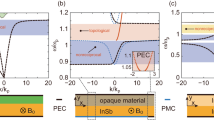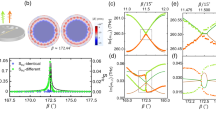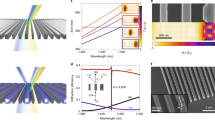Abstract
Waves entering a spatially uniform lossy medium typically undergo exponential intensity decay, arising from either the energy loss of the Beer–Lambert–Bouguer transmission law or the evanescent penetration during reflection. Recently, exceptional point singularities in non-Hermitian systems have been linked to unconventional wave propagation. Here, we theoretically propose and experimentally demonstrate exponential decay free wave propagation in a purely lossy medium. We observe up to 400-wave deep polynomial wave propagation accompanied by a uniformly distributed energy loss across a nanostructured photonic slab waveguide with exceptional points. We use coupled-mode theory and fully vectorial electromagnetic simulations to predict deep wave penetration manifesting spatially constant radiation losses through the entire structured waveguide region regardless of its length. The uncovered exponential decay free wave phenomenon is universal and holds true across all domains supporting physical waves, finding immediate applications for generating large, uniform and surface-normal free-space plane waves directly from dispersion-engineered photonic chip surfaces.
This is a preview of subscription content, access via your institution
Access options
Access Nature and 54 other Nature Portfolio journals
Get Nature+, our best-value online-access subscription
$29.99 / 30 days
cancel any time
Subscribe to this journal
Receive 12 print issues and online access
$259.00 per year
only $21.58 per issue
Buy this article
- Purchase on Springer Link
- Instant access to full article PDF
Prices may be subject to local taxes which are calculated during checkout




Similar content being viewed by others
Data availability
The data that support the findings of this study are available from the corresponding authors upon reasonable request.
References
Miri, M.-A. & Alù, A. Exceptional points in optics and photonics. Science 363, eaar7709 (2019).
Özdemir, Ş., Rotter, S., Nori, F. & Yang, L. Parity–time symmetry and exceptional points in photonics. Nat. Mater. 18, 783–798 (2019).
Peng, B. et al. Loss-induced suppression and revival of lasing. Science 346, 328–332 (2014).
Peng, B. et al. Chiral modes and directional lasing at exceptional points. Proc. Natl Acad. Sci. USA 113, 6845–6850 (2016).
Brandstetter, M. et al. Reversing the pump dependence of a laser at an exceptional point. Nat. Commun. 5, 4034 (2014).
Hodaei, H., Miri, M.-A., Heinrich, M., Christodoulides, D. N. & Khajavikhan, M. Parity-time–symmetric microring lasers. Science 346, 975–978 (2014).
Feng, L., Wong, Z. J., Ma, R.-M., Wang, Y. & Zhang, X. Single-mode laser by parity-time symmetry breaking. Science 346, 972–975 (2014).
Chen, W., Özdemir, Ş. K., Zhao, G., Wiersig, J. & Yang, L. Exceptional points enhance sensing in an optical microcavity. Nature 548, 192–196 (2017).
Hodaei, H. et al. Enhanced sensitivity at higher-order exceptional points. Nature 548, 187–191 (2017).
Guo, A. et al. Observation of P T-symmetry breaking in complex optical potentials. Phys. Rev. Lett. 103, 093902 (2009).
Rüter, C. E. et al. Observation of parity–time symmetry in optics. Nat. Phys. 6, 192–195 (2010).
Peng, B. et al. Parity–time-symmetric whispering-gallery microcavities. Nat. Phys. 10, 394–398 (2014).
Feng, L. et al. Demonstration of a large-scale optical exceptional point structure. Opt. Express 22, 1760–1767 (2014).
Regensburger, A. et al. Parity–time synthetic photonic lattices. Nature 488, 167–171 (2012).
Doppler, J. et al. Dynamically encircling an exceptional point for asymmetric mode switching. Nature 537, 76–79 (2016).
Poli, C., Bellec, M., Kuhl, U., Mortessagne, F. & Schomerus, H. Selective enhancement of topologically induced interface states in a dielectric resonator chain. Nat. Commun. 6, 1–5 (2015).
Weimann, S. et al. Topologically protected bound states in photonic parity–time-symmetric crystals. Nat. Mater. 16, 433–438 (2017).
Shen, H., Zhen, B. & Fu, L. Topological band theory for non-Hermitian Hamiltonians. Phys. Rev. Lett. 120, 146402 (2018).
Yoon, J. W. et al. Time-asymmetric loop around an exceptional point over the full optical communications band. Nature 562, 86–90 (2018).
Lin, Z. et al. Unidirectional invisibility induced by PT-symmetric periodic structures. Phys. Rev. Lett. 106, 213901 (2011).
Feng, L. et al. Experimental demonstration of a unidirectional reflectionless parity-time metamaterial at optical frequencies. Nat. Mater. 12, 108–113 (2013).
Zhen, B. et al. Spawning rings of exceptional points out of Dirac cones. Nature 525, 354–358 (2015).
Lee, S.-G. & Magnusson, R. Band flips and bound-state transitions in leaky-mode photonic lattices. Phys. Rev. B 99, 045304 (2019).
Daxhelet, X. & Kulishov, M. Theory and practice of long-period gratings: when a loss becomes a gain. Opt. Lett. 28, 686–688 (2003).
Kulishov, M., Jones, H. & Kress, B. Analysis of PT-symmetric volume gratings beyond the paraxial approximation. Opt. Express 23, 9347–9362 (2015).
Kulishov, M., Kress, B. & Slavík, R. Resonant cavities based on parity-time-symmetric diffractive gratings. Opt. Express 21, 9473–9483 (2013).
Makris, K. G., Musslimani, Z. H., Christodoulides, D. N. & Rotter, S. Constant-intensity waves and their modulation instability in non-Hermitian potentials. Nat. Commun. 6, 1–7 (2015).
Makris, K., Krešić, I., Brandstötter, A. & Rotter, S. Scattering-free channels of invisibility across non-Hermitian media. Optica 7, 619–623 (2020).
Makris, K. G., Ge, L. & Türeci, H. Anomalous transient amplification of waves in non-normal photonic media. Phys. Rev. X 4, 041044 (2014).
Rivet, E. et al. Constant-pressure sound waves in non-Hermitian disordered media. Nat. Phys. 14, 942–947 (2018).
Hardy, A., Welch, D. F. & Streifer, W. Analysis of second-order gratings. IEEE J. Quantum Electron. 25, 2096–2105 (1989).
Kazarinov, R. & Henry, C. Second-order distributed feedback lasers with mode selection provided by first-order radiation losses. IEEE J. Quantum Electron. 21, 144–150 (1985).
Hsu, C. W., Zhen, B., Stone, A. D., Joannopoulos, J. D. & Soljačić, M. Bound states in the continuum. Nat. Rev. Mater. 1, 16048 (2016).
Koshelev, K., Lepeshov, S., Liu, M., Bogdanov, A. & Kivshar, Y. Asymmetric metasurfaces with high-Q resonances governed by bound states in the continuum. Phys. Rev. Lett. 121, 193903 (2018).
Yesilkoy, F. et al. Ultrasensitive hyperspectral imaging and biodetection enabled by dielectric metasurfaces. Nat. Photonics 13, 390–396 (2019).
Kim, S. et al. Photonic waveguide to free-space Gaussian beam extreme mode converter. Light Sci. Appl. 7, 72 (2018).
Yulaev, A. et al. Metasurface-integrated photonic platform for versatile free-space beam projection with polarization control. ACS Photonics 6, 2902–2909 (2019).
Hummon, M. T. et al. Photonic chip for laser stabilization to an atomic vapor with 10−11 instability. Optica 5, 443–449 (2018).
Berman, P. R. Atom Interferometry (Academic Press, 1997).
Acknowledgements
A.Y. acknowledges support under the Professional Research Experience Program (PREP), funded by the National Institute of Standards and Technology and administered through the Department of Chemistry and Biochemistry, University of Maryland. We also thank T. LeBrun, H. Lezec, J. Liu, J. A. Liddle and E. Secula for reading the manuscript and making insightful comments. The research was performed in part at the NIST Center for Nanoscale Science and Technology. This work is partially supported by the NIST-on-a-chip programme.
Author information
Authors and Affiliations
Contributions
A.Y. and S.K. contributed to the project equally. S.K. conceived the idea. A.Y. and S.K. performed FEM and FDTD simulations. D.A.W. and A.Y. fabricated samples. Q.L., B.J.R. and K.S. contributed to the experimental device design and fabrication process development. A.Y. and S.K. characterized samples. A.Y. and V.A.A. developed theoretical analysis. A.Y., S.K. and V.A.A. contributed to the data interpretation. V.A.A. supervised the project. The manuscript was written through the extensive contributions of all authors. All authors have approved the final version of the manuscript.
Corresponding authors
Ethics declarations
Competing interests
The authors declare no competing interests.
Peer review
Peer review information
Nature Nanotechnology thanks Stefan Rotter and the other, anonymous, reviewer(s) for their contribution to the peer review of this work.
Additional information
Publisher’s note Springer Nature remains neutral with regard to jurisdictional claims in published maps and institutional affiliations.
Extended data
Extended Data Fig. 1 Free-space beam angle and intensity dependences on the optical wavelength.
(a) The orange curve shows the radiation angle as a function of the wavelength for DC = 0.527. The black dashed line indicates 0°. (b) The corresponding band diagram (BD) for infinite grating. The dashed blue arrows depict the wavelength tuning. Once the wavelength crosses the EPs in the BD (panel b), the outcoupling angle experiences high variation about the chip’s normal, that is noticeable as a double kink in the wavelength dependence of the outcoupled angle (panel a).
Extended Data Fig. 2 Spatially uniform and non-uniform energy losses in non-Hermitian periodically structured media excited from one side.
FEM simulated time-averaged power flow along the uniform periodically structured waveguide in the positive z-direction (a) and averaged |E| over one grating period (low-pass spatial filtering) (b) vs. the coordinate z for the optical frequency tuned to the EP wavelength (red curve) and detuned (black curve) from the EP wavelength. The waveguide is excited by a wave incident from the left side at z = 10 µm.
Extended Data Fig. 3 Linear radiative energy losses experimentally observed in 45 µm, 100 µm, 180 µm, and 250 µm long gratings with ≈ 50 % DC.
Insets depict top-view optical images of the projected free-space beams. The saturated ≈ 20 µm wide spike at the grating input is due to the fabrication imperfections related to the electron lithography proximity effect (Supplementary Fig. 10).
Extended Data Fig. 4 Sample fabrication flowchart.
The partially etched gratings and supporting photonic structures are fabricated by sequential electron beam lithography patterning and etching of a silicon nitride layer, followed by silicon dioxide cladding deposition, as described in the Sample Fabrication section of the Methods.
Extended Data Fig. 5 Experimental apparatus.
Light from a tunable laser was fiber coupled through an attenuator (A) and polarization controller (PC) to the inverted taper waveguide couplers on the grating chip (device under test, DUT). Grating emission was imaged by a microscope camera. Free space linear polarizer P was used for polarization selective imaging to tune the input fiber polarization to transverse electric. Images were captured at the grating plane with additional images captured above the grating plane to assess emission angle.
Supplementary information
Supplementary Information
Supplementary discussion and Figs. 1–13.
Rights and permissions
About this article
Cite this article
Yulaev, A., Kim, S., Li, Q. et al. Exceptional points in lossy media lead to deep polynomial wave penetration with spatially uniform power loss. Nat. Nanotechnol. 17, 583–589 (2022). https://doi.org/10.1038/s41565-022-01114-3
Received:
Accepted:
Published:
Issue Date:
DOI: https://doi.org/10.1038/s41565-022-01114-3
This article is cited by
-
Exceptional points and non-Hermitian photonics at the nanoscale
Nature Nanotechnology (2023)
-
Highly-twisted states of light from a high quality factor photonic crystal ring
Nature Communications (2023)



